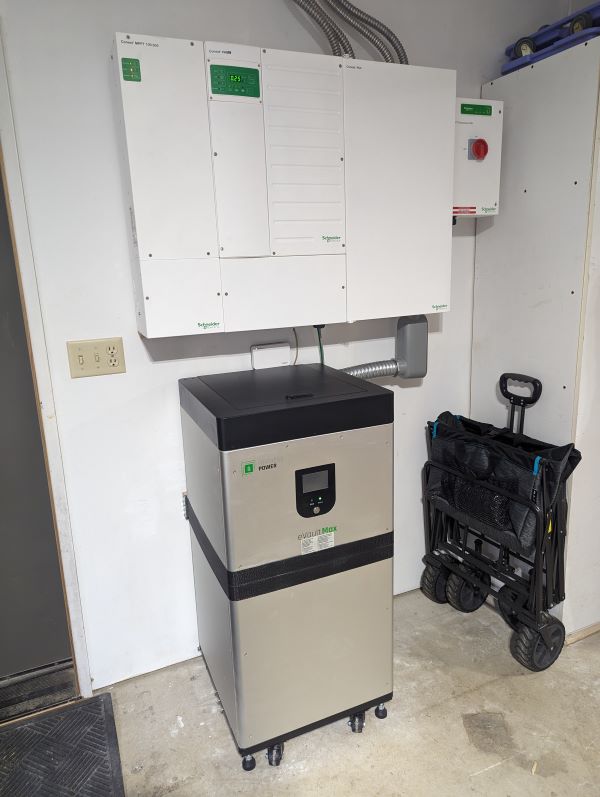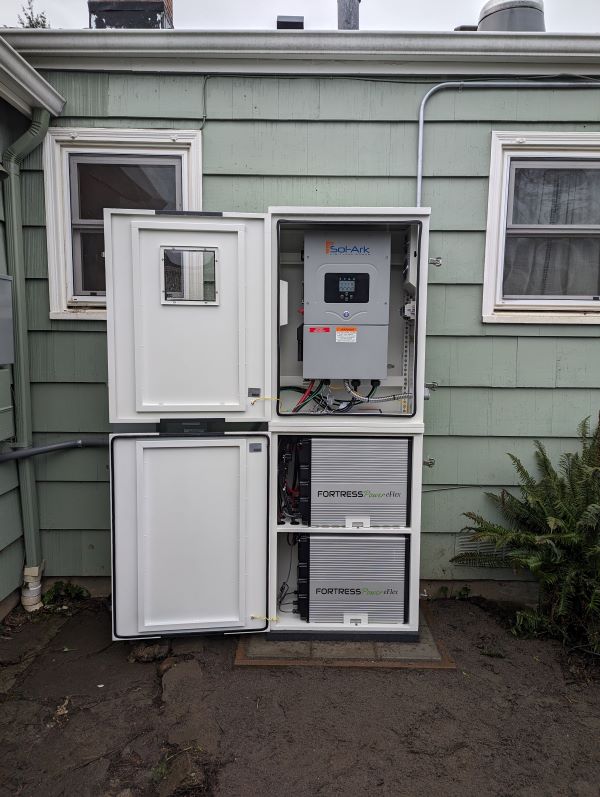
Be prepared for emergencies
Grid-tied with battery back-up systems are becoming more popular as emergency preparedness has become a high priority for many people. Abundant Solar has installed various products for local battery storage and is your local expert in design, installation, and maintenance of battery storage systems.


How Battery Grid-Tied Systems Work
When the grid goes down, your battery system will feed stored energy into your home. As you use power from your batteries, your solar system will generate more electricity to refill that storage.
Most grid-tied with battery back-up systems have a dedicated back-up loads panel that is powered by the batteries during an outage. Common residential loads placed in the back-up panel are well pump, refrigerator, freezer, lights, communications, furnace blower (for gas or pellet stoves) and a few strategic receptacles.
Larger loads like electric heat, electric water heater (some heat pump water heaters are okay), electric range, electric dryers and ducted heat pumps are excluded from back-up as they drain batteries too quickly.
During a long-term power outage, low electricity heat sources such as wood or pellet stoves, gas furnaces and ductless heat pumps (depending on size) are used to conserve back-up power. Small induction cooktops, microwaves and other fast cooking small appliances are good ways to cook food with electricity from a back-up system.
Fossil fuel generators can be incorporated into back-up systems to charge batteries and power back-up loads during an outage with low solar input. Grid-tied with battery back-up systems are currently about double the cost of a grid-tied only system.
What to Consider Before Going Solar
Reduce Your Current Energy Consumption
Solar electricity is a wonderful way to meet your energy needs, however, it is expensive. Changing some of the ways you use your electricity and being more conservative could reduce the overall size and cost of your solar electricity system significantly.
Make Your House More Energy Efficient
Consider how to make some energy efficiency improvements such as insulation, windows, fluorescent lights, or replacing old appliances that could reduce your energy consumption. There are great incentive programs in Oregon for heat pumps too!
Make Sure Your Property Is Suited For Solar
It is best to consult a professional to design your solar system, but there are some basic things to consider. Do you have available roof space that faces south, west or east? Do those roof areas get significant sun or is your home shaded by trees most of the day? Is there a sunny area of the property that is large enough to mount solar panels on the ground? Energy Trust of Oregon and Oregon Department of Energy require a minimum “solar resource factor” to qualify for rebates. Typically, we can get a good idea of this with modern satellite imagery and software We verify your site in person before the start of every project.
Building a new home?
Please check out this how-to guide when building a new home. You only get one chance to design and build each house and making it more efficient and ready for solar is a great way to set yourself up for the future.
Incentives
Energy Trust of Oregon
Are you a Pacific Power Customer? Energy Trust of Oregon has incentives for your battery back-up project. Energy Trust’s Solar Within Reach program offers increased incentives for qualifying incomes.
Oregon Solar and Storage Rebate
Oregon homeowners can receive a rebate of up to $2,500 for an energy storage system. The amount of funds for this program is limited and subject to a first come first serve basis. Once we create a contract with a customer, we reserve these funds for your project. Currently this program is still funded as of March 2024!
Federal Tax Credit
If you install solar energy equipment on your residence (or rental) any time this year through the end of 2032, you are entitled to a nonrefundable credit off your federal income taxes equal to 30 percent of eligible expenses. There’s no dollar limit on those expenses; you’re entitled to that 30 percent tax break whether you spend $20,000 or more than $100,000 on costs associated with a residential solar system.
Net Metering
Net metering simply means that the utility pays the customer the same rate as the customer pays the utility for exported solar generation on either a monthly or annual basis. For Pacific Power and Consumers Power customers, the utilities will allow customers to bank excess energy until the March billing cycle of the following year. As long as you size the system to your annual needs or a little bit smaller, you will receive full retail value for all of the power you produce until the utility year-end date. Learn more about the Net Metering rules at your utility:
Net Metering is forecasted to change in the coming years. California changed their net metering policy in 2023 and now the utilities only pay consumers 25% of what they used to for their exported solar energy. Consumers who installed solar before this change were “grandfathered” with the former retail rate. Now is a great time to choose Abundant Solar to install your solar system.
